View in other NatureServe Network Field Guides
NatureServe
Montana
Utah
Wyoming
Idaho
Wisconsin
British Columbia
South Carolina
Yukon
California
New York
Idaho Sedge - Carex idahoa
Other Names:
Carex parryana ssp. idahoa
State Rank Reason (see State Rank above)
Idaho sedge is a regional endemic known from several dozen sites in Montana which cluster into approx 15-20 populations, most on public lands. The estimated number of stems is in the tens of thousands, but total occupied habitat has been estimated at less than 200 acres. The species is palatable, and populations may be affected by heavy grazing. Other risks are competition from exotic species, hydrologic alterations, agricultural development and road construction/maintenance. Updated population data and related site information are needed.
- Details on Status Ranking and Review
Population Size
Score1-2 - Small to Moderate. Population size is imprecisely known but is believed to be >2,000 individuals and <100,000 individuals.
Range Extent
Score2 - Regional or State Endemic or Small Montana Range: Generally restricted to an area <100,000 sq. miles (equivalent to 2/3 the size of Montana or less) or Montana contributes 50% or more of the species’ range or populations OR limited to 2-3 Sub-basins in Montana.
CommentMontana contributes a significant percentage of the species' rangewide population.
Area of Occupancy
Score1 - Moderate: Generally occurring in 11-25 Subwatersheds (6th Code HUC’s).
Environmental Specificity
Score1 - Moderate: Species is restricted to a specific habitat that is more widely distributed or to several restricted habitats and is typically dependent upon relatively unaltered, good-quality habitat (C Values of 5-7).
Trends
Score1-2 - Minor to Moderate Declines:
CommentTrend data are lacking, though it appears likely that some declines have occurred due to adverse impacts to habitat quality and/or quantity over the last several decades.
Threats
Score2 - High: 31-70% of the populations are being negatively impacted or are likely to be impacted by one or more activities or agents, which are expected to result in decreased populations and/or habitat quality and/or quantity.
CommentThreats include habitat alteration and conversion from agricultural and ranching activities, heavy grazing pressure and competition from non-native species. Current, site-specific information is lacking for many sites.
Intrinsic Vulnerability
Score0-1 - Low to Moderate Vulnerability.
Raw Conservation Status Score
Score
8 to 11 total points scored out of a possible 19.
General Description
Short-rhizomatous. Stems erect, 12–60 cm, tufted. Leaves: basal and lower-cauline; blades 2–4 mm wide. Inflorescence of usually 3 subsessile, erect, overlapping spikes; lowest bract short. Spikes 6–25 mm long; uppermost largest, female or bisexual with male flowers below; lower all female. Perigynia ascending, green, pappilose, obovoid, 2.5–3 mm long, with a brown, serrulate beak ca. 0.3 mm long; stigmas 3. Female scales lanceolate, black with a pale midstripe, concealing the perigynia, becoming shorter and more rounded above. Achene 3-sided, nearly filling the perigynium (
Lesica et al. 2012. Manual of Montana Vascular Plants. BRIT Press. Fort Worth, TX).
Phenology
Fruits mature in July-August.
Diagnostic Characteristics
Carex idahoa is difficult to distinguish from Carex parryana and Carex hallii. The uppermost spikes of Carex parryana are cylindrical and all more-or-less equal in size, while in Carex idahoa and Carex hallii, the terminal spike is enlarged and club-shaped. Female scales of C. hallii are as long as the perigynia, while they are much shorter than the perigynia in C. idahoa. This species has been previously treated as C. parryana ssp. idahoa.
Species Range
Montana Range
Range Descriptions
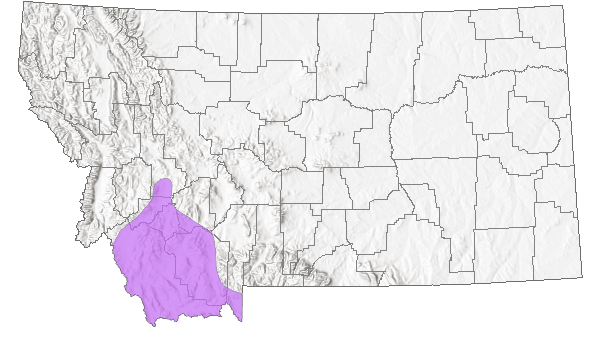
 Native
Native
Range Comments
MT, OR, ID, CA and UT (Lesica et al. 2012. Manual of Montana Vascular Plants. BRIT Press. Fort Worth, TX).
Observations in Montana Natural Heritage Program Database
Number of Observations: 71
(Click on the following maps and charts to see full sized version)
Map Help and Descriptions
Relative Density
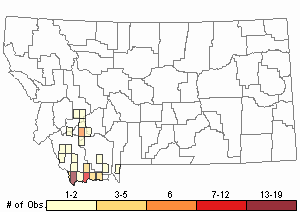
Recency
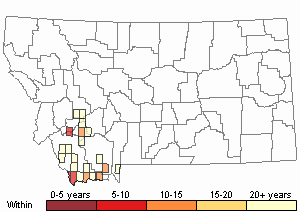

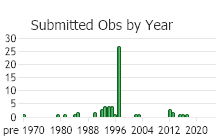
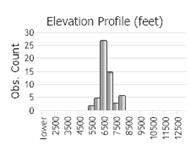 (Observations spanning multiple months or years are excluded from time charts)
(Observations spanning multiple months or years are excluded from time charts)
Habitat
Idaho sedge inhabits moist alkaline meadows, often along streams (Vanderhorst and Lesica 1994). It most often occupies ecotonal areas between wet meadow and sagebrush steppe (Lesica 1998), and appears to be restricted to nearly level sites in the high valleys of southwest Montana. It is commonly found on terraces of headwaters streams above 6000 feet elevation. Small populations may occur at lower elevations or along larger streams. Soils tend to be silty, with high organic content and little or no coarse material (Lesica 1998). Most documented Montana populations are in areas with calcareous parent material, however a few occupy non-calcareous sites.
The moist, alkaline, streamside meadow habitat of Idaho sedge is typically dominated by graminoids (especially Deschampsia caespitosa, Juncus balticus, Carex praegracilis, C. nebrascensis, C. aquatilis), with or without Potentilla fruticosa (Vanderhorst and Lesica 1994; Lesica 1998). Adjacent steppe vegetation is dominated by Artemisia tridentata and/or A. tripartita, Festuca idahoensis and Agropyron smithii. Species most commonly associated with Idaho sedge are (in order of importance) Juncus balticus, C. praegracilis, Muhlenbergia richardsonis, Aster occidentalis, Poa pratensis, Taraxacum officinale, Potentilla gracilis and Antennaria microphylla. Graminoid cover is high (60-100%), and forb cover low to moderate (5-50%) except in overgrazed areas. Bare ground averages 8% and cover of lichens and bryophytes averages 14% (Lesica 1998).
Idaho sedge consistently occurs in subirrigated soils associated with low-gradient streams or springs and seeps. These soils are wet early in the growing season but are only moist later in the summer. In wetlands where part of the habitat was saline (as indicated by the presence of Distichlis and Puccinellia), it is usually limited to non-saline areas, although it has been found in salt-encrusted soils (Lesica 1998).
National Vegetation Classification System Groups Associated with this Species
Wetland and Riparian
Peatland
Wet Meadow and Marsh
Ecology
Flooding is probably uncommon in most of these habitats, as they tend to occur in headwaters areas where snow accumulation and stream gradients are low (Lesica 1998). Although fire was common in high-elevation steppe vegetation in southwest Montana prior to European settlement, it probably did not play an important role in the dynamics of herbaceous riparian wetlands (Lesica 1998).
Management
Idaho sedge can probably tolerate light to moderate livestock grazing but will decline under heavy grazing (Lesica 1998). Its wetland habitat is favored by cattle and frequently subject to overgrazing on both public and private lands. Graminoids such as sedges are adapted to grazing and are usually able to persist with light to moderate grazing pressure (Lesica 1998). Evidence suggests that this species responds to grazing like a typical palatable graminoid, and is capable of tolerating light to moderate grazing, but would likely decline under continuous heavy grazing. This is based on correlation data and studies of other, anatomically similar species. Experiments and monitoring studies to determine the actual response of Idaho sedge have not been conducted (Lesica 1998), however grazing regimes that permit 50% or less annual utilization and allow seed production and dispersal at regular intervals would likely be compatible with its survival. Almost all known populations of the species on public lands are subject to livestock grazing, as is much of its habitat on private land (Lesica 1998). Its mesic habitat provides high quality, green forage for livestock throughout the summer and is a magnet for cattle, often leading to overgrazing. Many of the small populations occur in localized springs, seeps or along small streams in extensive semi-arid steppe, and are particularly at risk from overgrazing, which can cause streambank destabilization followed by lowering of the water table and a loss of riparian vegetation (Lesica 1998). Populations in larger wetland areas may not face such intensive grazing pressure.
Large areas of potential habitat for this species in southern Beaverhead County are mowed for hay.
While the effects of mowing on native vegetation are unknown, plowing and seeding of non-native species almost certainly have adverse effects on native communities and may result in local extirpation of native species. Poa pratensis (Kentucky bluegrass) is the only exotic plant documented with significant frequency in this species' habitat (Lesica 1998). It is a rhizomatous grass similar in stature to Idaho sedge, and may compete with it, especially where there is grazing and trampling by livestock. Taraxacum officinale (dandelion) and Trifolium repens (clover) occur at some sites, but these are short plants that increase only where heavy grazing removes the larger graminoids, and by themselves do not pose a threat to Idaho sedge.
Roads are often constructed along or adjacent to riparian areas, and have impacted wetland habitat for three Idaho sedge populations (Lesica 1998). A fourth is vulnerable to road improvement and construction. Road development can reduce or degrade habitat through increased runoff, pollution and physical disturbance. Ranch and recreational use of such roads probably has little impact on the species, however maintenance or widening can lead to habitat loss. A portion of Moose Creek, where one population occurs, has been dredged, presumably for mineral extraction (Lesica 1998). Dredging most likely reduces the extent and character of riparian vegetation, and may reduce habitat for Idaho sedge. Fortunately, most populations do not occur in areas prone to mining activity.
Stewardship Responsibility
Threats or Limiting Factors
STATE THREAT SCORE REASON
Reported threats to Montana's populations of Idaho Sedge are factors that damage individuals or reduce habitat quality (MTNHP Threat Assessment 2021). Most populations are on public lands where trampling by recreational users and livestock is ongoing. Idaho Sedge occurs in moist meadows where livestock tend to inflict more frequent and severe impacts. Herbivory reduces plant viability and concentrated trampling reduces habitat quality by compacting soil, promoting spread of non-native plants, and potentially contributes to local water table decline. Surface water diversion, commonly used to develop stock tank sites, also threatens Idaho Sedge when dewatering or inundation is a consequence.
References
- Literature Cited AboveLegend:
 View Online Publication
View Online Publication Lesica, P., M.T. Lavin, and P.F. Stickney. 2012. Manual of Montana Vascular Plants. Fort Worth, TX: BRIT Press. viii + 771 p.
Lesica, P., M.T. Lavin, and P.F. Stickney. 2012. Manual of Montana Vascular Plants. Fort Worth, TX: BRIT Press. viii + 771 p. MTNHP Threat Assessment. 2021. State Threat Score Assignment and Assessment of Reported Threats from 2006 to 2021 for State-listed Vascular Plants. Botany Program, Montana Natural Heritage Program, Helena, Montana.
MTNHP Threat Assessment. 2021. State Threat Score Assignment and Assessment of Reported Threats from 2006 to 2021 for State-listed Vascular Plants. Botany Program, Montana Natural Heritage Program, Helena, Montana.
- Additional ReferencesLegend:
 View Online Publication
View Online Publication
Do you know of a citation we're missing? Culver, D.R. 1994. Floristic analysis of the Centennial Region, Montana. M.Sc. Thesis. Montana State University, Bozeman. 199 pp.
Culver, D.R. 1994. Floristic analysis of the Centennial Region, Montana. M.Sc. Thesis. Montana State University, Bozeman. 199 pp. Hahn, B.E. 1977. Flora of Montana: conifers and monocots. Montana State Univ., Bozeman.
Hahn, B.E. 1977. Flora of Montana: conifers and monocots. Montana State Univ., Bozeman. Hermann, F. J. 1970. Manual of the Carices of the Rocky Mountains and Colorado Basin. Agricultural Handbook No. 374. USDA Forest Service. 397 pp.
Hermann, F. J. 1970. Manual of the Carices of the Rocky Mountains and Colorado Basin. Agricultural Handbook No. 374. USDA Forest Service. 397 pp. Lesica, P. 1998. Conservation status of Carex parryana ssp. Idahoa in Montana. Unpublished report to Bureau of Land Management. Montana Natural Heritage Program, Helena. 32 pp. plus appendices.
Lesica, P. 1998. Conservation status of Carex parryana ssp. Idahoa in Montana. Unpublished report to Bureau of Land Management. Montana Natural Heritage Program, Helena. 32 pp. plus appendices. Lesica, P., M.T. Lavin, and P.F. Stickney. 2022. Manual of Montana Vascular Plants, Second Edition. Fort Worth, TX: BRIT Press. viii + 779 p.
Lesica, P., M.T. Lavin, and P.F. Stickney. 2022. Manual of Montana Vascular Plants, Second Edition. Fort Worth, TX: BRIT Press. viii + 779 p. Mincemoyer, S. 2005. Surveys of significant plant resources and related vegetation types for the Butte Office of the Bureau of Land Management. Montana Natural Heritage Program, Helena, MT. 11 pp + appendices.
Mincemoyer, S. 2005. Surveys of significant plant resources and related vegetation types for the Butte Office of the Bureau of Land Management. Montana Natural Heritage Program, Helena, MT. 11 pp + appendices. Vanderhorst, J.P. and P. Lesica. 1995a. Sensitive plant survey of the Tendoy Mountains in the Beaverhead National Forest, Beaverhead County, Montana. Unpublished report to the Bureau of Land Management, Butte District. Montana Natural Heritage Program, Helena, MT. 59 pp. plus appendices.
Vanderhorst, J.P. and P. Lesica. 1995a. Sensitive plant survey of the Tendoy Mountains in the Beaverhead National Forest, Beaverhead County, Montana. Unpublished report to the Bureau of Land Management, Butte District. Montana Natural Heritage Program, Helena, MT. 59 pp. plus appendices.
- Web Search Engines for Articles on "Idaho Sedge"





